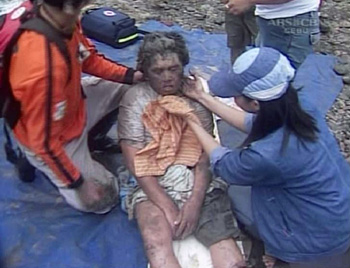|
Philippines landslide deaths may top 1,500
(AP/Xinhua)
Updated: 2006-02-18 08:19 A second, minor landslide added to volunteers' jitters, and a helicopter
pilot said the ground near the top of the mountain was still moving in late
afternoon.
"You could see a patch of green, then mud where it was," Leo Dimaala said,
estimating that half the mountain had collapsed.

A woman is surrounded by rescuers after a
landslide in Leyte province in this February 17, 2006 video grab.
Mudslides triggered by heavy rains buried hundreds of houses and a school
in the central Philippines on Friday, killing at least six people and
raising fears of a far higher death toll, officials and witnesses said.
There were unconfirmed reports at least 200 people could be dead and about
1,500 missing around Saint Bernard town in Leyte province, said Senator
Richard Gordon, who also heads the Philippine Red Cross.
[Reuters] | Education officials said 250 pupils
and teachers were believed to have been at the elementary school at the time of
the major landslide Friday morning. Only one girl and a woman were rescued alive
nearby.
Two other villages also were affected, and about 3,000 evacuees huddled at a
municipal hall.
"We did not find injured people," said Ricky Estela, a crewman on a
helicopter that flew a politician to the scene. "Most of them are dead and
beneath the mud."
Aerial TV footage showed a wide swath of mud alongside stretches of green
rice paddies at the foothills of the scarred mountain.
Pat Vendetti, a London-based campaigner with the Greenpeace environmental
action group, said illegal logging may prove to have contributed to the
mudslide.
"There were similar landslides at the end of 2004 and the end of 2003, both
directly linked to illegal logging on land above villages, and both in the
Philippines," said Vendetti.
The International Federation of Red Cross and Red Crescent Societies blamed a
combination of the weather and the type of trees prevalent in the area.
"The remote coastal area of southern Leyte ... is heavily forested with
coconut trees," the Red Cross said from Geneva. "They have shallow roots, which
can be easily dislodged after heavy rains, causing the land to become unstable.
Lerias said that even before the landslide, "trees were sliding down upright
with the mud."
A small earthquake also shook the area, but scientists said it took place
after the landslide and probably was unrelated.
Rescue workers dug with shovels for signs of survivors, and put a child on a
stretcher, with little more than the girl's eyes showing through a covering of
mud.
"Help is on the way," President Gloria Macapagal Arroyo said in televised
remarks. "It will come from land, sea and air."
The Philippine Red Cross had 14 people on the ground dealing with rescue
efforts and the recovery of bodies. More staff and trained volunteers were being
sent to the region, along with dog rescue teams.
A relief plane was flying from Manila carrying 1,000 body bags, emergency
trauma kits to help 1,000 people, rubber boots, ropes, clothing, flashlights and
medicine.
The international Red Cross launched an emergency appeal for $1.5 million for
relief operations. The funds will be used for buying temporary shelter materials
and other emergency health and cooking items.
The U.S. military dispatched at least two warships and other forces to the
scene to provide medical assistance and other relief.
|